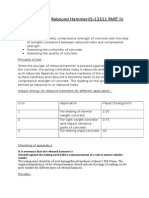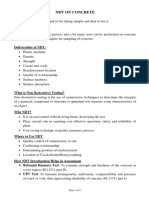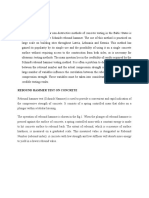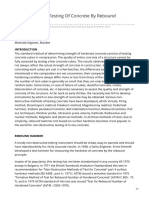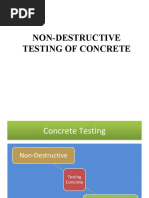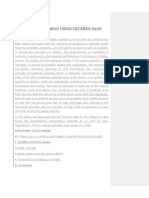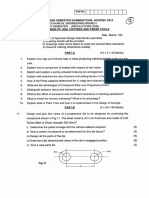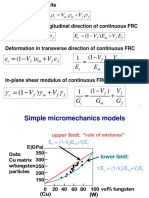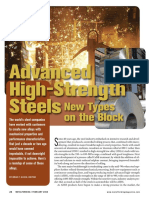0 ratings0% found this document useful (0 votes)
56 viewsProcedure For Rebound Hammer Test
Procedure For Rebound Hammer Test
Uploaded by
habap27388The procedure for a rebound hammer test on concrete structures involves first calibrating the hammer on a steel test anvil. Then, the hammer is held at right angles to the concrete surface to take readings either horizontally on vertical surfaces or vertically on horizontal surfaces. Multiple readings are taken at each point and averaged. The rebound number indicates the compressive strength of the concrete to a limited depth from the surface, though many factors can influence the results. Correlating rebound numbers to compressive strength tests on cores from the structure can improve the accuracy of using this method to estimate concrete strength.
Copyright:
© All Rights Reserved
Available Formats
Download as DOCX, PDF, TXT or read online from Scribd
Procedure For Rebound Hammer Test
Procedure For Rebound Hammer Test
Uploaded by
habap273880 ratings0% found this document useful (0 votes)
56 views3 pagesThe procedure for a rebound hammer test on concrete structures involves first calibrating the hammer on a steel test anvil. Then, the hammer is held at right angles to the concrete surface to take readings either horizontally on vertical surfaces or vertically on horizontal surfaces. Multiple readings are taken at each point and averaged. The rebound number indicates the compressive strength of the concrete to a limited depth from the surface, though many factors can influence the results. Correlating rebound numbers to compressive strength tests on cores from the structure can improve the accuracy of using this method to estimate concrete strength.
Original Title
Procedure for Rebound Hammer Test
Copyright
© © All Rights Reserved
Available Formats
DOCX, PDF, TXT or read online from Scribd
Share this document
Did you find this document useful?
Is this content inappropriate?
The procedure for a rebound hammer test on concrete structures involves first calibrating the hammer on a steel test anvil. Then, the hammer is held at right angles to the concrete surface to take readings either horizontally on vertical surfaces or vertically on horizontal surfaces. Multiple readings are taken at each point and averaged. The rebound number indicates the compressive strength of the concrete to a limited depth from the surface, though many factors can influence the results. Correlating rebound numbers to compressive strength tests on cores from the structure can improve the accuracy of using this method to estimate concrete strength.
Copyright:
© All Rights Reserved
Available Formats
Download as DOCX, PDF, TXT or read online from Scribd
Download as docx, pdf, or txt
0 ratings0% found this document useful (0 votes)
56 views3 pagesProcedure For Rebound Hammer Test
Procedure For Rebound Hammer Test
Uploaded by
habap27388The procedure for a rebound hammer test on concrete structures involves first calibrating the hammer on a steel test anvil. Then, the hammer is held at right angles to the concrete surface to take readings either horizontally on vertical surfaces or vertically on horizontal surfaces. Multiple readings are taken at each point and averaged. The rebound number indicates the compressive strength of the concrete to a limited depth from the surface, though many factors can influence the results. Correlating rebound numbers to compressive strength tests on cores from the structure can improve the accuracy of using this method to estimate concrete strength.
Copyright:
© All Rights Reserved
Available Formats
Download as DOCX, PDF, TXT or read online from Scribd
Download as docx, pdf, or txt
You are on page 1of 3
Procedure for Rebound Hammer Test
Procedure for rebound hammer test on concrete structure starts with
calibration of the rebound hammer. For this, the rebound hammer is tested
against the test anvil made of steel having Brinell hardness number of about
5000 N/mm2. After the rebound hammer is tested for accuracy on the test
anvil, the rebound hammer is held at right angles to the surface of the concrete
structure for taking the readings. The test thus can be conducted horizontally
on vertical surface and vertically upwards or downwards on horizontal
surfaces as shown in figure below If the rebound hammer is held at
intermediate angle, the rebound number will be different for the same
concrete.
Fig.2.Rebound Hammer Positions for Testing Concrete Structure
Points to Remember in Rebound Hammer Test
1. The concrete surface should be smooth, clean and dry.
2. Ant loose particles should be rubbed off from the concrete surface
with a grinding wheel or stone, before hammer testing.
3. Rebound hammer test should not be conducted on rough surfaces as a
result of incomplete compaction, loss of grout, spalled or tooled
concrete surface.
4. The point of impact of rebound hammer on concrete surface should be
at least 20mm away from edge or shape discontinuity.
5. Six readings of rebound number is taken at each point of testing and
an average of value of the readings is taken as rebound index for the
corresponding point of observation on concrete surface.
Interpretation of Rebound Hammer Test Results
After obtaining the correlation between compressive strength and rebound
number, the strength of structure can be assessed. In general, the rebound
number increases as the strength increases and is also affected by a number of
parameters i.e. type of cement, type of aggregate, surface condition and
moisture content of the concrete, curing and age of concrete, carbonation of
concrete surface etc.
Fig.3.Relationship Between Cube Strength and the Rebound
Number
Moreover the rebound index is indicative of compressive strength of concrete
up to a limited depth from the surface. The internal cracks, flaws etc. or
heterogeneity across the cross section will not be indicated by rebound
numbers. Table-2 below shows the quality of concrete for respective average
rebound number.
Table.2. Quality of Concrete for different values of rebound
number
As such the estimation of strength of concrete by rebound hammer method
cannot be held to be very accurate and probable accuracy of prediction of
concrete strength in a structure is ± 25 percent. If the relationship between
rebound index and compressive strength can be found by tests on core
samples obtained from the structure or standard specimens made with the
same concrete materials and mix proportion, then the accuracy of results and
confidence thereon gets greatly increased.
You might also like
- Reinforced Concrete Buildings: Behavior and DesignFrom EverandReinforced Concrete Buildings: Behavior and DesignRating: 5 out of 5 stars5/5 (1)
- Non Destructive Testing of ConcreteDocument6 pagesNon Destructive Testing of ConcreteAatif100% (1)
- Rebound Hammer TestDocument8 pagesRebound Hammer TestEvello MercanoNo ratings yet
- Rebound Hammer Test On ConcreteDocument10 pagesRebound Hammer Test On ConcreteSunil KumarNo ratings yet
- Rebound Hammer PresentationDocument18 pagesRebound Hammer PresentationMohmed RiazNo ratings yet
- report 3Document17 pagesreport 3benjiebaun0918No ratings yet
- Interpretation of Rebound Hammer Test ResultsDocument2 pagesInterpretation of Rebound Hammer Test ResultssamNo ratings yet
- Rebound HammerDocument6 pagesRebound HammerDira AzmanNo ratings yet
- Rebound HammerDocument5 pagesRebound HammerSunil KumarNo ratings yet
- Rebound Hammer (NDT)Document2 pagesRebound Hammer (NDT)rexdindigulNo ratings yet
- 4 ReportDocument4 pages4 ReportSandeep ShetNo ratings yet
- NDT - RHDocument2 pagesNDT - RHRajesh KumarNo ratings yet
- NDT On Concrete: Destructive TestingDocument11 pagesNDT On Concrete: Destructive TestingMITHLESH KUMAR KESHARINo ratings yet
- Rebound Hammer Seminar FinalDocument24 pagesRebound Hammer Seminar FinalsajithNo ratings yet
- Rebound Hammer TestDocument13 pagesRebound Hammer Testjohnelya736No ratings yet
- Nondestructive Testing and Evaluation in Structural AnalysisDocument14 pagesNondestructive Testing and Evaluation in Structural AnalysisChalakAhmedNo ratings yet
- Rebound Hammer TestDocument14 pagesRebound Hammer TestChalakAhmed100% (6)
- Sop of Rebound Hammer TestDocument3 pagesSop of Rebound Hammer Testmohd waseemNo ratings yet
- Rebound Hammer PDFDocument6 pagesRebound Hammer PDFAnonymous AJy7S7flB100% (2)
- Finding Compressive Strength Using Schmidt Hammer TestDocument13 pagesFinding Compressive Strength Using Schmidt Hammer TestChalakAhmedNo ratings yet
- Rebound Hammer TestDocument2 pagesRebound Hammer TestAafan ShahidNo ratings yet
- Rebound Number of Hardened ConcreteDocument5 pagesRebound Number of Hardened ConcreteTabish IslamNo ratings yet
- Rebound Hammer ReportDocument17 pagesRebound Hammer ReportSYaz WAni25% (4)
- Rebound Hammer Test Procedure For Concrete HardnessDocument4 pagesRebound Hammer Test Procedure For Concrete HardnessSite Engineer.2p2No ratings yet
- Rebound Hammer-RH (Schmidt) TestDocument2 pagesRebound Hammer-RH (Schmidt) TestmandregomesNo ratings yet
- Methods for Testing Compressive Strength of ConcreteDocument12 pagesMethods for Testing Compressive Strength of ConcretekhaleelmasheeNo ratings yet
- Hammer Test (Rebound)Document2 pagesHammer Test (Rebound)Rasya FiezaNo ratings yet
- Hand Out NDT - 1437658138730Document7 pagesHand Out NDT - 1437658138730deveki nandan shuklaNo ratings yet
- R2013 Concrete Lab-FinalDocument91 pagesR2013 Concrete Lab-Finalgandhi mohanNo ratings yet
- Rebound Hammer Test PDFDocument6 pagesRebound Hammer Test PDFjayaram miryalaNo ratings yet
- Literatur Review On Rebound HammerDocument4 pagesLiteratur Review On Rebound HammerAnshul JainNo ratings yet
- Rebound Hammer TestDocument4 pagesRebound Hammer TestMd Imtiazul AlamNo ratings yet
- Testing Fresh Concrete. Slump TestDocument6 pagesTesting Fresh Concrete. Slump TestkhaledNo ratings yet
- Non-Destructive Testing of Concrete by Rebound HammerDocument7 pagesNon-Destructive Testing of Concrete by Rebound HammerPradeep PokhrelNo ratings yet
- Non-Destructive Testing of Concrete by Rebound HammerDocument6 pagesNon-Destructive Testing of Concrete by Rebound HammerPoirei ZildjianNo ratings yet
- Concrete Slump Test For Workability - Procedure and ResultsDocument4 pagesConcrete Slump Test For Workability - Procedure and ResultsJhundel Factor PajarillagaNo ratings yet
- Non-Destructive Testing of Concrete by Rebound HammerDocument7 pagesNon-Destructive Testing of Concrete by Rebound HammerRajesh KumarNo ratings yet
- Mohamad 2015Document14 pagesMohamad 2015Silvio JúniorNo ratings yet
- Common Mistake by Engineers During RCC WorksDocument4 pagesCommon Mistake by Engineers During RCC WorksAnonymous P7VckOJZUgNo ratings yet
- Reference Notes - Tests For ConcreteDocument21 pagesReference Notes - Tests For ConcreteMitali KhedkarNo ratings yet
- Tests For Concrete - NotesDocument31 pagesTests For Concrete - Notessrushtideokar0537No ratings yet
- Rebound Hammer TestDocument7 pagesRebound Hammer TestHaider AliNo ratings yet
- Rebound Hammer Test.: By: Akshay R Manohar Mtech-Construction Technology Civil Engineering Dept. Nmamit-NitteDocument23 pagesRebound Hammer Test.: By: Akshay R Manohar Mtech-Construction Technology Civil Engineering Dept. Nmamit-NitteBaibaswata DasNo ratings yet
- 3-Non Destructive Testing of ConcreteDocument31 pages3-Non Destructive Testing of ConcreteAhtisham KhanNo ratings yet
- Non Destructive Test Methods 1Document9 pagesNon Destructive Test Methods 1Imtiaz AhmadNo ratings yet
- Tests On Concrete (Viva Voce)Document4 pagesTests On Concrete (Viva Voce)Mani KandanNo ratings yet
- Is 13311 - 2Document9 pagesIs 13311 - 2Sravan KumarNo ratings yet
- What Is Stamped ConcreteDocument6 pagesWhat Is Stamped ConcreteNick GeneseNo ratings yet
- Institute of Civil EngineerinDocument7 pagesInstitute of Civil Engineerinheherson juanNo ratings yet
- Daja 6Document15 pagesDaja 6محمد الدعجةNo ratings yet
- Non Destructive Test On ConcreteDocument6 pagesNon Destructive Test On ConcreteOpany JuliusNo ratings yet
- Concrete Mix Design: MR - Pavan N. Neve Visiting Faculty GcoejDocument26 pagesConcrete Mix Design: MR - Pavan N. Neve Visiting Faculty GcoejPavan WaniNo ratings yet
- Core Strength Variation of In-Place Concrete - tcm77-1305833Document3 pagesCore Strength Variation of In-Place Concrete - tcm77-1305833usama anterNo ratings yet
- Properties of Fresh ConcreteDocument10 pagesProperties of Fresh ConcreteCholwe Essau MbilimaNo ratings yet
- Non Destructive Testing of ConcteteDocument19 pagesNon Destructive Testing of ConcteteRamsharan DhakalNo ratings yet
- Concrete Mix Design Using Crushed SandDocument22 pagesConcrete Mix Design Using Crushed SandOlaolu Olalekan50% (2)
- Civil Engineering Material (Sea2112)Document10 pagesCivil Engineering Material (Sea2112)Thiva RajanNo ratings yet
- CT Lab Manual 2021 BatchDocument58 pagesCT Lab Manual 2021 BatchAnirudh BhardwajNo ratings yet
- What Is The Ratio of Grades M10Document6 pagesWhat Is The Ratio of Grades M10jaisaraNo ratings yet
- Alkenes 2Document25 pagesAlkenes 2habap27388No ratings yet
- CROSS WORD 1aDocument2 pagesCROSS WORD 1ahabap27388No ratings yet
- InSpace Brochure 28th June 2023Document8 pagesInSpace Brochure 28th June 2023habap27388No ratings yet
- Academic Calendar 2nd Semester of AY 2022-23 and 1st Semester of AY 2023-24 For Continuing StudentsDocument3 pagesAcademic Calendar 2nd Semester of AY 2022-23 and 1st Semester of AY 2023-24 For Continuing Studentshabap27388No ratings yet
- Students List - Chemistry Cycle Sections I Sem-AY2022-23Document81 pagesStudents List - Chemistry Cycle Sections I Sem-AY2022-23habap27388No ratings yet
- Column N BeamDocument27 pagesColumn N BeamCherryl Chrissie JamesNo ratings yet
- ISO 5832-11 2014 (E) Implants For Surgery - Metallic Materials - Part 11 Wrought Titanium 6-Aluminium 7-Niobium AlloyDocument10 pagesISO 5832-11 2014 (E) Implants For Surgery - Metallic Materials - Part 11 Wrought Titanium 6-Aluminium 7-Niobium AlloySunny PanwarNo ratings yet
- FIRE FIGHTING INSTALLATION BOQ Wenz WorldDocument5 pagesFIRE FIGHTING INSTALLATION BOQ Wenz Worldmunshimbwe munshimbweNo ratings yet
- Astm D1384 04Document3 pagesAstm D1384 04fuenmayor.lilibethNo ratings yet
- Anna University ME 9301 Design of Jigs. Fixtures and Press Tools Question PaperDocument5 pagesAnna University ME 9301 Design of Jigs. Fixtures and Press Tools Question PaperMuruga AnanthNo ratings yet
- Conversion FactorsDocument10 pagesConversion FactorsJohn MofireNo ratings yet
- Bar No - 5763: Test CertificateDocument2 pagesBar No - 5763: Test Certificateshrikant bhirudNo ratings yet
- Deep DrawingDocument46 pagesDeep DrawingAshwin.DNo ratings yet
- Micromechanics-Lecture 14Document10 pagesMicromechanics-Lecture 14Steve LinkingNo ratings yet
- Petropipe Brochure (English)Document16 pagesPetropipe Brochure (English)Nuaym KhalidNo ratings yet
- Masonry-Materials-Monitoring (EAST)Document2 pagesMasonry-Materials-Monitoring (EAST)Michael Astilla MantalabaNo ratings yet
- Advance StructuresDocument6 pagesAdvance StructuresManju NishaNo ratings yet
- Composición Química de Aleaciones de CobreDocument71 pagesComposición Química de Aleaciones de Cobreitiz2013100% (1)
- Cast Copper, Flared Tube & DWV Fittings: Solder Joint Pressure FittingsDocument4 pagesCast Copper, Flared Tube & DWV Fittings: Solder Joint Pressure Fittingsadventure11111No ratings yet
- Revised Data (Buildings)Document95 pagesRevised Data (Buildings)sasidharkatari91572No ratings yet
- Engineering MaterialsDocument9 pagesEngineering Materialsbharatharuru955aNo ratings yet
- PFS Unit 1Document23 pagesPFS Unit 1jss_devNo ratings yet
- Iso 8504-3-1993-08Document9 pagesIso 8504-3-1993-08Zaheer Ahmad RazaNo ratings yet
- LSI Courtsider Series Tennis Court Lighting Spec Sheet 1990Document2 pagesLSI Courtsider Series Tennis Court Lighting Spec Sheet 1990Alan MastersNo ratings yet
- Iso 5817 Level PDFDocument19 pagesIso 5817 Level PDFbeto206123No ratings yet
- Arca South Pie Parcel 1 and 3 ProjectDocument24 pagesArca South Pie Parcel 1 and 3 ProjectRoSs Adrales ArelegNo ratings yet
- Schedule of Rates: Items Description Unit Quantity Rate Amount Sub Head 1: Earth WorkDocument99 pagesSchedule of Rates: Items Description Unit Quantity Rate Amount Sub Head 1: Earth WorkDaljeet SidhuNo ratings yet
- BoqDocument76 pagesBoqArnold LundayNo ratings yet
- F 492 - 95 - RJQ5MGDocument5 pagesF 492 - 95 - RJQ5MGCeratita ClarkNo ratings yet
- CSR-2014 Kohistan KPKDocument11 pagesCSR-2014 Kohistan KPKdiamer bashaNo ratings yet
- Chap 4 CastingProcessesDocument48 pagesChap 4 CastingProcessesTshiamo MontsoNo ratings yet
- En 10305 en 10296Document4 pagesEn 10305 en 10296Siti Zaleha HmlonNo ratings yet
- Q4 Lesson 4 SolderingDocument39 pagesQ4 Lesson 4 SolderingLyndseyNo ratings yet
- Point Supported Glass DetailsDocument2 pagesPoint Supported Glass DetailsKoala BNo ratings yet
- Astm A36 PDFDocument5 pagesAstm A36 PDFAnindya Aulia Pratiwi67% (3)











